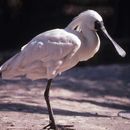Biology
provided by Arkive
The breeding season begins in early May and nests are constructed upon cliffs; the clutch size is usually three eggs. Breeding success is relatively low but fledging generally occurs at around five weeks old (4). By mid-August, the young are independent and the annual migration to the wintering grounds can begin. These birds are relatively gregarious, roosting together in flocks usually during daylight hours (4). Foraging may also occur in groups, and flocks of around 25 birds have been seen feeding on the mud flats, their bills just skimming the surface of the water for food (4). A variety of tidal species are taken, from small fish to crabs and shrimp; foraging appears to take place in the dark or is dependent on the tide (4).
Conservation
provided by Arkive
The black-faced spoonbill is protected in China, Taiwan, North Korea, South Korea and Japan, and a number of both breeding and wintering sites are protected as sanctuaries (2). An Action Plan for the species was produced in 1995, following an international workshop; the Wild Bird Society of Japan acts as the secretariat of the Black-faced Spoonbill Conservation Network (4). Educational and research programmes have been undertaken in a number of countries, and an international census has been established and run by Hong Kong Bird Watching Society (5).
Description
provided by Arkive
The black-faced spoonbill is a relatively small wading bird with, as its name would suggest, an elongated, spoon-shaped bill. The plumage is white in colour, and the face and bill are black (2). During the breeding season, mature adults develop longer crest feathers at the back of the neck, and these and the breast area become a golden yellow (5). Adult black-faced spoonbills have red eyes and yellow patches on their cheeks (6). Male black-faced spoonbills can be distinguished from females by their longer bills; while the bills of immature birds are a pinkish-grey rather than black (5).
Habitat
provided by Arkive
Inhabits intertidal habitats along the coast; nesting occurs on cliffs close to tidal flats, whilst winter grounds are situated on estuary wetlands, mudflats and mangroves (4).
Range
provided by Arkive
Found along the east Asian coast, these birds are known to breed on islands off the coast of North and South Korea and in Liaoning Province, China. Following the breeding season, the population migrates to wintering grounds at three major sites: Tsengwen Estuary, Taiwan, Inner Deep Bay, Hong Kong, and the Red River Delta, Vietnam (2).
Status
provided by Arkive
Classified as Endangered (EN) on the IUCN Red List 2007 (1), and listed on Appendix I of the Convention on Migratory Species (CMS or Bonn Convention) (3).
Threats
provided by Arkive
Habitat destruction in the form of the alteration and drainage of wetlands for aquaculture and industrial development is probably the biggest threat to the survival of the black-faced spoonbill (4). The small number of wintering sites means that the species is very vulnerable to any chance event that may occur, particularly to the potentially catastrophic effects of pollution (4).

